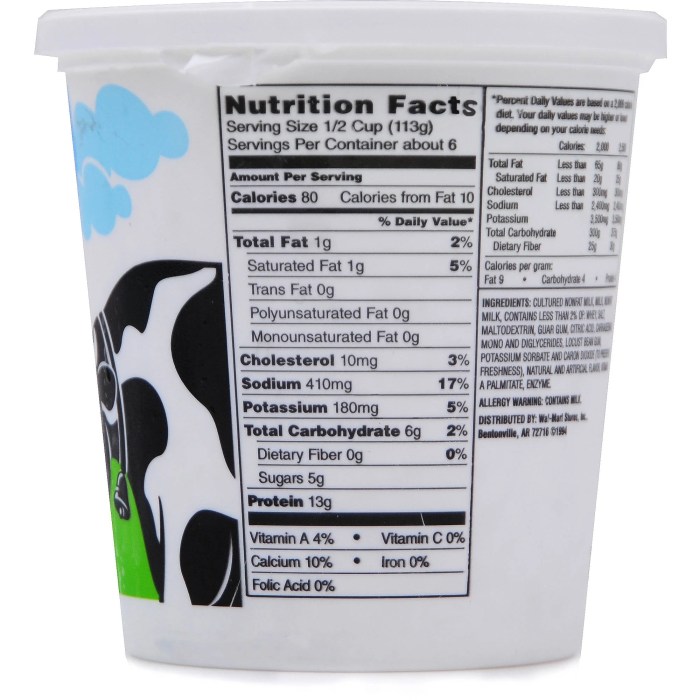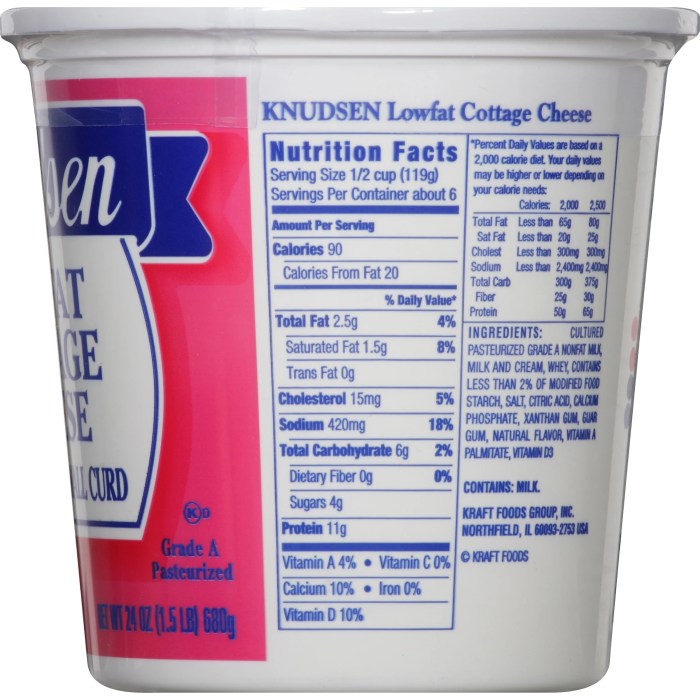Nutritional Profile of Nonfat Cottage Cheese

Cottage cheese nutrition nonfat – A pale, yielding curd, a whisper of salt, nonfat cottage cheese offers a quiet strength, a nutritional balm for the weary soul. Its simplicity belies a complex tapestry of nutrients, a subtle symphony played on the palate and within the body. Let us delve into its composition, a melancholic exploration of its quiet virtues.
Macronutrient Composition of Nonfat Cottage Cheese
A typical serving (1 cup or approximately 225 grams) of nonfat cottage cheese provides a substantial amount of protein, a meager offering of fat, and a moderate amount of carbohydrates. The exact values may vary slightly depending on the brand and manufacturing process, but a general approximation offers a glimpse into its nutritional heart. One might find approximately 28 grams of protein, less than 0.5 grams of fat, and around 6 grams of carbohydrates.
This translates to a significant percentage of daily protein intake, while remaining remarkably low in fat and relatively moderate in carbohydrates. The protein content, a cornerstone of muscle repair and satiety, stands as a beacon in this nutritional landscape.
Vitamin and Mineral Content of Nonfat Cottage Cheese, Cottage cheese nutrition nonfat
| Nutrient | Amount (per 1 cup serving) | % Daily Value (approximate) | Benefits |
|---|---|---|---|
| Protein | 28g | 56% | Muscle building, satiety, immune function |
| Calcium | 15% DV | 15% | Bone health, muscle function, nerve transmission |
| Vitamin B12 | 10% DV | 10% | Red blood cell formation, nerve function |
| Riboflavin (B2) | 15% DV | 15% | Energy metabolism, healthy skin |
| Selenium | 10% DV | 10% | Antioxidant, thyroid hormone production |
The vitamins and minerals present, though not lavish, offer a comforting presence, a quiet support to the body’s intricate mechanisms. Each nutrient plays a vital, if understated, role in maintaining overall health and well-being.
Glycemic Index and Glycemic Load of Nonfat Cottage Cheese
Nonfat cottage cheese possesses a relatively low glycemic index (GI) and glycemic load (GL). This means that it causes a slow and gradual rise in blood sugar levels, making it a suitable choice for individuals managing diabetes or those seeking to maintain stable blood sugar levels. The low carbohydrate content and the presence of protein contribute to this effect.
The slow release of glucose into the bloodstream offers a comforting steadiness, a gentle rhythm in contrast to the sharp peaks and valleys of high-GI foods. This steady release provides sustained energy without the dramatic fluctuations that can lead to energy crashes and cravings.
Considerations and Potential Drawbacks: Cottage Cheese Nutrition Nonfat

A pallid moon hangs heavy, casting long shadows on the simple pleasures. Nonfat cottage cheese, a dietary staple for some, holds a bittersweet truth: while offering nutritional benefits, its excessive consumption can cast a pall over one’s well-being. Like a song played on a cracked violin, its virtues are tinged with a melancholic undercurrent of potential downsides.The allure of nonfat cottage cheese, with its protein richness and low-calorie count, can lead to overindulgence.
This, however, may not always be a harmonious symphony for the body. Just as a garden overgrown with one type of flower loses its vibrancy, a diet dominated by even the healthiest food can lack the balance necessary for optimal health.
High Sodium Content
While nonfat, many varieties of cottage cheese contain a significant amount of sodium. Excessive sodium intake can contribute to high blood pressure and water retention, potentially leading to discomfort and health complications. Imagine a heart burdened by excess weight, its rhythm disrupted by the relentless pressure. Choosing low-sodium options or carefully monitoring intake is crucial to avoid this.
Lactose Intolerance
Cottage cheese, despite being a fermented dairy product, still contains lactose. Individuals with lactose intolerance may experience digestive discomfort, including bloating, gas, and diarrhea, after consuming even small amounts. This can transform a seemingly innocuous food into a source of considerable distress, a bitter note in an otherwise pleasant tune.
Potential Interactions with Medications
Certain medications, particularly those affecting calcium metabolism, can interact with the high calcium content of cottage cheese. For example, some medications used to treat hypercalcemia might have their effectiveness altered by the additional calcium intake. This delicate balance, like a finely tuned instrument, can be easily disrupted. Consultation with a physician or registered dietitian is essential to ensure safe and effective management of medications and dietary choices.
Individual Dietary Needs and Preferences
The nutritional needs and preferences of individuals vary greatly. While nonfat cottage cheese is a nutritious option for many, it might not be suitable for everyone. Dietary restrictions, allergies, or personal taste preferences should always guide food choices. A diet should be a personal melody, composed to suit one’s unique needs and desires, not a forced march to a pre-ordained rhythm.
Yo, so you’re checking out cottage cheese nutrition nonfat, huh? That’s a solid choice, man! But if you’re feeling adventurous, you might wanna check out the frigo cheese heads nutrition facts too, for a different cheesy vibe. Then, you can compare and decide which better suits your diet – cottage cheese’s low-fat goodness or the cheesy goodness of Frigo.
Either way, you’re gonna be cheesin’!
Visual Representation of Nutritional Information

A pallid landscape, the nonfat cottage cheese sits, a humble offering. Its texture, a delicate dance between creamy smoothness and the faintest suggestion of curds, a whisper of solidity against the tongue. The color, a muted off-white, like a forgotten moon, holds a subtle luminescence, hinting at the hidden nourishment within. Each small, irregular clump reflects the soft light, a silent testament to its simple composition.
A Visual Depiction of Macronutrient Proportions
Imagine a circle, a pale disc mirroring the bowl of cottage cheese itself. This circle, our visual representation, is divided into segments, each a different shade, representing the macronutrients. The largest segment, a soft, creamy beige, dominates the pie chart, representing the protein content – the sturdy backbone of this simple food. A smaller, almost translucent slice of pale blue occupies a modest portion, representing carbohydrates – a fleeting whisper of sweetness.
Finally, a tiny sliver of deep emerald green, barely noticeable, represents the negligible fat content – a ghost of richness. The muted tones reflect the understated nature of the food itself, a quiet strength in its simplicity. The visual immediately conveys the dominance of protein in this nonfat variant, a stark contrast to the richer, fuller versions.
Question Bank
Is nonfat cottage cheese good for weight loss?
Yes, its high protein content promotes satiety, helping you feel fuller for longer and potentially reducing overall calorie intake. It’s also relatively low in calories compared to other dairy options.
Can I eat nonfat cottage cheese every day?
Moderation is key with any food. While it’s nutritious, daily consumption should be part of a balanced diet and consider individual needs and potential interactions with medications or health conditions.
Does nonfat cottage cheese contain lactose?
Yes, it does contain lactose, although the amount can vary depending on the brand and processing. Individuals with lactose intolerance may need to consume it in moderation or choose lactose-free alternatives.
How long can I store nonfat cottage cheese?
Check the “best by” date on the container. Once opened, store it in the refrigerator and consume it within a few days for optimal freshness and quality.
